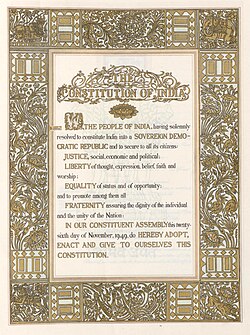Constitution of India
| Part of a series on |
| Constitution of India |
|---|
 |
| Preamble |
The Constitution of India is the supreme law of India. It is a living document, the permanent instrument which makes the government system work. It lays down the framework defining fundamental political principles, establishes the structure, procedures, powers and duties of government institutions and sets out fundamental rights, directive principles and the duties of citizens. It is the longest written constitution of any sovereign country in the world. The nation is governed on the basis of this Constitution. Dr. Bhimrao Ramji Ambedkar is regarded as the chief architect of the Indian Constitution
The constitution of India imparts constitutional supremacy and not parliamentary supremacy as it is not created by the Parliament but created by a constituent assembly and adopted by its people with a declaration in the preamble to the constitution. Parliamentcannot override the constitution.
The Constitution was adopted by the Constituent Assembly on 26 November 1949, and came into effect on 26 January 1950. The date of 26 January was chosen to commemorate the Purna Swaraj declaration of independence of 1930. With its adoption, theUnion of India officially became the modern and contemporary Republic of India and it replaced the Government of India Act 1935 as the country's fundamental governing document. To ensure constitutional autochthony, the framers of constitution repealed the prior Acts of the British Parliament via the Article 395 of the constitution. India celebrates the coming into force of the constitution on 26 January each year as Republic Day.
The Constitution declares India a sovereign, secular, democratic republic, assuring its citizens of justice, equality, and liberty, and endeavors to promote fraternity among them.


No comments:
Post a Comment